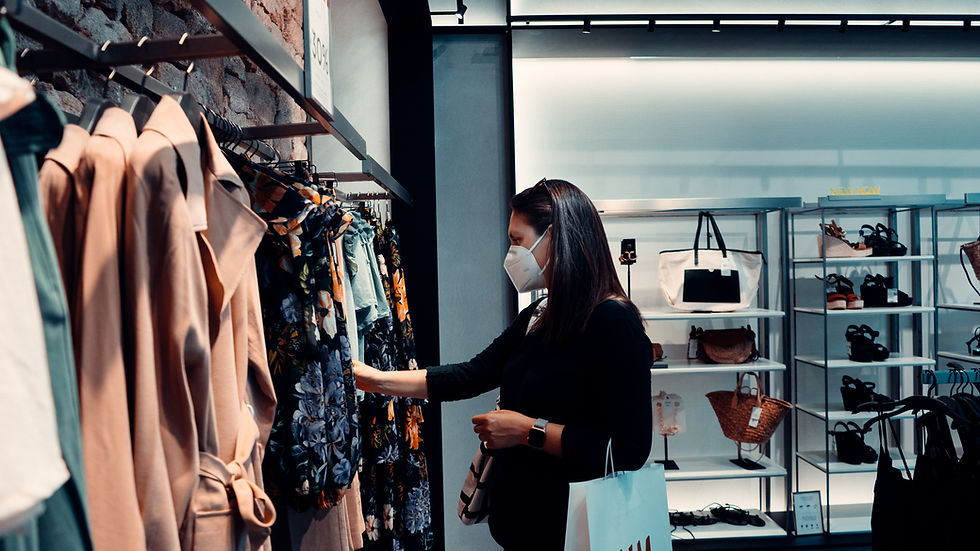Consumer behavior-driven retail trends in 2020
- Sam

- Jun 24, 2020
- 3 min read
Terms such as “Pandemic” and “COVID-19” have normalized by now and the situation has adversely impacted industries such as airline, leisure facilities, auto parts & equipment, and oil and gas drilling. As a result, companies have laid off their employees and have cut down salaries by a significant amount. Meanwhile, some industries thrived in this situation, namely delivery services, grocery stores, and gaming. However, this chaotic situation has completely remodeled the lifestyle of consumers.

Out of the many precautionary measures, regular hand washing and social distancing are the most commonly advised and used preventive methods. While people adhere to these precautionary measures, mandatory social distancing has paved the way for online shopping as 30% of consumers have stopped shopping in physical stores instead, they now rely on online shopping more than usual. As a result, online spending has increased by 10-30% across grocery and non-grocery items. Further anatomy of online spending reveals that consumers spend more on medicine (20-25%), healthcare services (10-15%), perishable grocery (10-15%), and grocery: dry goods (15-20%). 10-30% across grocery and non-grocery items may seem like a small increase but in reality, it’s an entirely different story as e-commerce spending in grocery itself has spiked significantly and at the same time spendings in other e-commerce categories have increased to a great extent although it’s not the same steep upward trend as the spending on groceries.

It is pretty clear that e-commerce has been the “knight in shining armor” for businesses operating in certain industries and it is the only ray of hope which startup companies and traditional companies (companies that are yet to adopt e-commerce) can use to overcome this crisis successfully. Although the perception of it was different prior to the pandemic situation. E-commerce and social media go hand in hand and several surveys have confirmed that social media usage has increased considerably as 39% of respondents have increased their social media usage. All these numbers may seem very appealing to many businesses (including businesses that are about to adopt e-commerce) however there are few notable points which corporates should be mindful about in regard to consumer behavior.
48% are remaining loyal to their usual/familiar brands.
21% are purchasing a mix of usual and new brands.
13% are “taking the opportunity to discover new brands”.
19% are feeling less brand loyal, buying what’s available.
No matter what industry you operate in, there are few important trends in retail technology which you should be aware of
1. Providing limitless access to products and services

Opening hours have become irrelevant and instead, consumers prefer to shop whenever they want. Businesses should develop online shops that provide unlimited access to all their products and services. Since social distancing is of paramount importance, getting products delivered to the doorstep can turn out to be rewarding in terms of brand perception eventually leading up to brand loyalty.
2. Creating immersive environments

Online shoppers prefer to do their shopping in immersive e-commerce platforms that make shopping fun. Companies can make their platforms more immersive through the use of AR (Augmented Reality) or VR or through a mix of matching color schemes and sound. The trick of having an immersive platform is that consumers are most likely to stay longer in your platform which ultimately triggers ‘impulse buying’.
It doesn't necessarily have to be the latest hype technology used to achieve this since a similar experience can be delivered through the tweaking of user experience design.
3. Make it exclusive

Companies can use the data which they have derived about consumer shopping preferences to provide personalized discounts and offers. Not only that, but you can also provide dedicated service or support to your most loyal customers to make them feel exclusive. Modern customers often tend to reward brands that provide personalized products or experiences.
4. Implement social shopping

Social media is the most popular choice for retailers to market their products successfully. Among many social media platforms, Facebook and Instagram are the most commonly used platforms for businesses. They use these platforms to provide that “look and feel” experience which then makes consumers feel that they are missing out on something worthwhile.
Also, businesses use the analytics feature provided by these platforms to gain deeper insight and provide a personalized service that casually blends with the customer which then helps to create a long-lasting rapport with the customer. Social media are also frequently used to offer flash deals and promotions that help to boost sales and gain an understanding of customer perception/sentiments.
E-commerce has always been a powerful tool in the retail industry and especially in times like this, it has proved its dominance in retail technology. Therefore, timely shifting is required to adopt these new global trends and the new normal. Visionstellar can help you in terms of making the shift, guiding you on the process, and actually get it done for you.





Comments